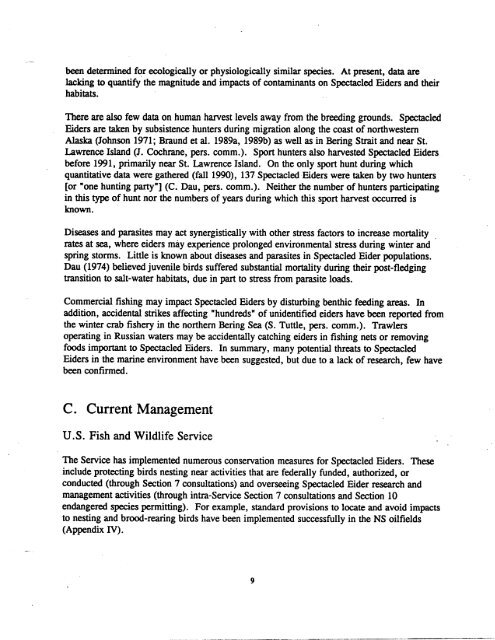A. Status of the Spectacled Eider - U.S. Fish and Wildlife Service
A. Status of the Spectacled Eider - U.S. Fish and Wildlife Service
A. Status of the Spectacled Eider - U.S. Fish and Wildlife Service
Create successful ePaper yourself
Turn your PDF publications into a flip-book with our unique Google optimized e-Paper software.
een determined for ecologically or physiologically similar species. At present, data are<br />
lacking to quantify <strong>the</strong> magnitude <strong>and</strong> impacts <strong>of</strong> contaminants on <strong>Spectacled</strong> <strong>Eider</strong>s <strong>and</strong> <strong>the</strong>ir<br />
habitats.<br />
There are also few data on human harvest levels away from <strong>the</strong> breeding grounds. <strong>Spectacled</strong><br />
<strong>Eider</strong>s are taken by subsistence hunters during migration along <strong>the</strong> coast <strong>of</strong> northwestern<br />
Alaska (Johnson 1971; Braund et al. 1989a, 1989b) as well as in Bering Strait <strong>and</strong> near St.<br />
Lawrence Isl<strong>and</strong> (J. Cochrane, pers. comm.). Sport hunters also harvested <strong>Spectacled</strong> <strong>Eider</strong>s<br />
before 1991, primarily near St. Lawrence Isl<strong>and</strong>. On <strong>the</strong> only sport hunt during which<br />
quantitative data were ga<strong>the</strong>red (fall 1990), 137 <strong>Spectacled</strong> <strong>Eider</strong>s were taken by two hunters<br />
[or“one hunting party”] (C. Dau, pers. comm.). Nei<strong>the</strong>r <strong>the</strong> number <strong>of</strong> hunters participating<br />
in this type <strong>of</strong> hunt nor <strong>the</strong> numbers <strong>of</strong> years during which this sport harvest occurred is<br />
known.<br />
Diseases <strong>and</strong> parasites may act synergistically with o<strong>the</strong>r stress factors to increase mortality<br />
rates at sea, where eiders may experience prolonged environmental stress during winter <strong>and</strong><br />
spring storms. Little is known about diseases <strong>and</strong> parasites in <strong>Spectacled</strong> <strong>Eider</strong> populations.<br />
Dau (1974) believed juvenile birds suffered substantial mortality during <strong>the</strong>ir post-fledging<br />
transition to salt-water habitats, due in part to stress from parasite loads.<br />
Commercial fishing may impact <strong>Spectacled</strong> <strong>Eider</strong>s by disturbing benthic feeding areas. In<br />
addition, accidental strikes affecting “hundreds” <strong>of</strong> unidentified eiders have been reported from<br />
<strong>the</strong> winter crab fishery in <strong>the</strong> nor<strong>the</strong>rn Bering Sea (S. Tuttle, pers. comm.). Trawlers<br />
operating in Russian waters may be accidentally catching eiders in fishing nets or removing<br />
foods important to <strong>Spectacled</strong> <strong>Eider</strong>s. In summary, many potential threats to <strong>Spectacled</strong><br />
<strong>Eider</strong>s in <strong>the</strong> marine environment have been suggested, but due to a lack <strong>of</strong> research, few have<br />
been confirmed.<br />
C. Current Management<br />
U.S. <strong>Fish</strong> <strong>and</strong> <strong>Wildlife</strong> <strong>Service</strong><br />
The <strong>Service</strong> has implemented numerous conservation measures for <strong>Spectacled</strong> <strong>Eider</strong>s. These<br />
include protecting birds nesting near activities that are federally funded, authorized, or<br />
conducted (through Section 7 consultations) <strong>and</strong> overseeing <strong>Spectacled</strong> <strong>Eider</strong> research <strong>and</strong><br />
management activities (through intra-<strong>Service</strong> Section 7 consultations <strong>and</strong> Section 10<br />
endangered species permitting). For example, st<strong>and</strong>ard provisions to locate <strong>and</strong> avoid impacts<br />
to nesting <strong>and</strong> brood-rearing birds have been implemented successfully in <strong>the</strong> NS oilfields<br />
(Appendix IV).<br />
9

















